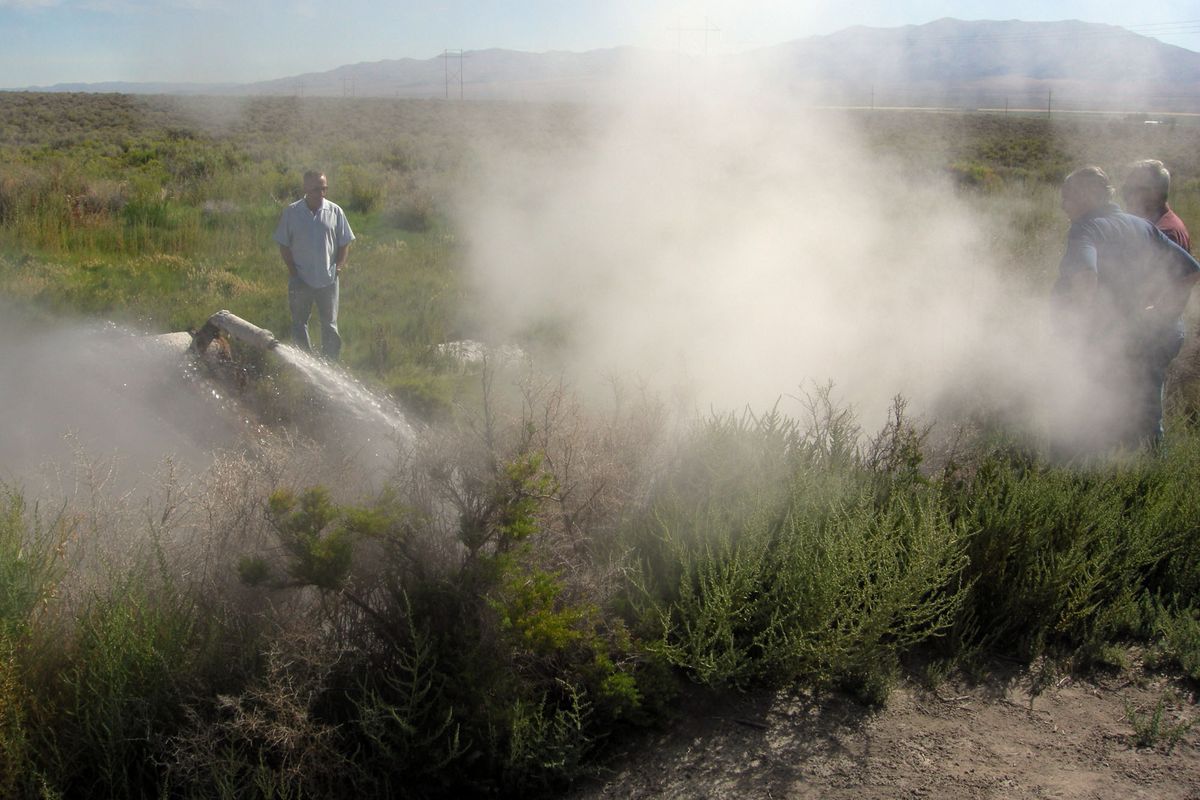Geothermal work tricky; upfront costs slow siting for companies

TWIN FALLS, Idaho – Idaho’s push for renewable energy is gaining strength.
Since 2008, federal stimulus dollars have combined with tax incentives to bring more renewable energy projects online as rising fuel prices made the ventures more lucrative.
In December, Idaho Power petitioned the Idaho Public Utilities Commission to severely cap the amount of intermittent renewable power it’s required to buy. This week, the petition was granted.
The rapid random proliferation of wind power projects across Idaho’s high desert prompted calls to regulate where the projects could be placed.
Earlier this month, U.S. Interior Secretary Ken Salazar held a two-day conference to address the administration’s efforts encouraging renewable energy projects on federal land while emphasizing responsible project siting. Much of the focus was on wind energy.
Barely scoring a mention was geothermal energy. With more obstacles to development, geothermal plants have spread more slowly, and siting hasn’t triggered much public concern.
But figuring out where to drill is a big concern to the developers.
Geothermal energy appears to be one of the best green energy sources. Plants release no greenhouse gases and, unlike solar and wind projects, produce energy continuously. They don’t dominate the landscape like wind turbines. Geothermal development isn’t hampered by the radioactive waste issues associated with nuclear energy.
But similar to nuclear energy, it has high upfront costs. Drilling deep into the Earth to find a suitable heat source is labor-intensive, expensive and without guarantee of success.
“Put drilling in front of anything and you’re talking bucks,” said Chris Harriman, president of Boise-based U.S. Geothermal Services.
To bore a mile into the Earth, crews may drill for weeks using dozens of $2,000 diamond bits to chew through everything from sediment to granite. But a project’s potential for success relies on finding a good site. Two traits are desirable for geothermal development: an area with subterranean heat that’s close to the surface and a relatively unhindered flow of underground water.
The hottest sites allow for the simplest, and thus the cheapest, technology: geothermal steam-driven turbines. So initially, developers focused on areas with obvious indicators of high underground heat and water: geysers.
Last year, 77 geothermal plants were online in the U.S. with 188 projects in development, according to a Geothermal Energy Association report.
With many known hot spring sites developed, developers are researching secondary sites. But even in areas of hot spring activity, no one is quite sure where is best to drill.
Although organizations such as the Idaho National Laboratory’s Geothermal Program have developed maps showing regions of likely activity, geothermal drilling still resembles wildcat drilling: There’s a a great deal of risk. If one well doesn’t yield, developers have to start over.
For that reason, geothermal energy supporters have lobbied for help from the federal government.
“We need a geothermal endowment,” said Dan Kunz, U.S. Geothermal CEO. “We have the geology here in Idaho but need to have people willing to take the risk to drill.”
U.S. Sen. Mike Crapo, R-Idaho, co-sponsored the Geothermal Energy Investment Act in September, which would have increased the investment tax credit for geothermal producers. A similar bill was introduced in the House in July. Neither made it out of committee.
Four bills were recently introduced in the Idaho Legislature to reduce leasing restrictions for geothermal projects on state land and give the land board more flexibility to negotiate royalties collected from projects on state land. State royalties are set at 10 percent of the value of the project’s product – electricity in this case – which is far greater than the 2 percent charged by the federal government.
While supportive of geothermal power, little in these bills helps defray upfront cost. They’d only help projects once they’re under way.
In a region of sagebrush just east of the Jim Sage Mountains in Cassia County, steam rises in the cold air from a small tributary of the Raft River. Hot springs may indicate hot water below, but it may not be hot enough to produce steam.
Such is the case at U.S. Geothermal’s Raft River plant, Idaho’s only such plant and the first in the Northwest.
The Raft River plant has a 20-year agreement with Idaho Power, in which Idaho Power pays for 10 megawatts a month at a rate equivalent to what it would pay for natural gas. Even with its efficiency issues, the rate is enough that the plant comes out ahead on its day-to-day operations.
One research group is trying to help Idaho developers reduce the guesswork and risks associated with drilling.
The DOE awarded around $4 million of stimulus funding to Utah State University for its Snake River Geothermal Drilling Project. In addition, the project participants, which include Boise State University and the U.S. Geological Survey, will ante up about $2 million to fund the drilling of three mile-deep exploration wells in southern Idaho.
But without other financial help, geothermal companies may not develop much, despite the good will.